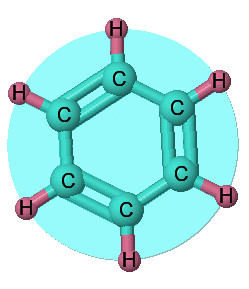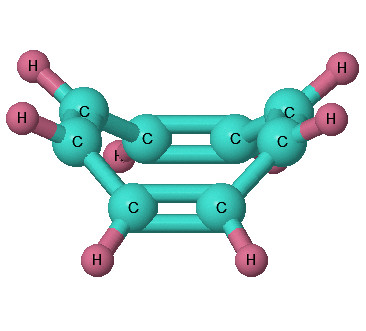Introduction to Annulenes
(Drag And Scroll to Animate Model)
Annulenes are monocyclic hydrocarbons that contain the maximum number of non-cumulated double bonds. They have the general formula CnHn (when n is an even number) or CnHn+1 (when n is an odd number). The IUPAC naming conventions are that annulenes with 7 or more carbon atoms are named as [n]annulene, where n is the number of carbon atoms in their ring.
1. Cyclobutadiene :
Cyclobutadiene is an organic compound with the formula C4H4. It is very reactive owing to its tendency to dimerize. Although the parent compound has not been isolated.The high energy of cyclobutadiene (CBD) is not due primarily to “anti-aromaticity,” but rather to angle strain, torsional strain, and Pauli repulsions.

Open in Full Screen
2. Benzene:
Benzene is an aromatic chemical which is a colorless or light yellow liquid at room temperature. It has a sweet odor and is highly flammable. Benzene is a natural part of crude oil and gasoline.It is widely used to make other chemicals ,used to make plastics, resins, and nylon and synthetic fibers. Benzene is also used to make some types of lubricants, rubbers, dyes, detergents, drugs, and pesticides.

Open in Full Screen
3. Cyclooctatetraene:
[8]Annulene,A polyunsaturated hydrocarbon is a colorless to light yellow flammable liquid at room temperature. Unlike benzene,cyclooctatetraene, C8H8, is tub shaped, nonaromatic, although its dianion, C 8H2−8 (cyclooctatetraenide), is. Its reactivity is characteristic of an ordinary polyene. it undergoes addition reactions.

Open in Full Screen
4. [10]-Annulene:
Cyclodecapentaene or [10]annulene is an annulene with molecular formula C10H10. This organic compound is a conjugated 10 pi electron cyclic system and according to Huckel's rule it should display aromaticity but It is not aromatic, however, because various types of ring strain destabilize an all-planar geometry. The all-cis isomer , a fully convex decagon, would have bond angles of 144 °, which creates large amounts of angle strain relative to the ideal 120° for sp2 atomic hybridization. Instead, the all-cis isomer can adopt a planar boat-like conformation to relieve the angle strain.This is still unstable because of the relative higher strain in boat shaped compared to the next planar trans, cis, trans, cis, cis isomer . Yet even this isomer is also unstable, suffering from steric repulsion between the two internal hydrogen atoms.

Open in Full Screen
5. [12]-Annulene:
Cyclododecahexaene is non-aromatic due to the lack of planarity of the structure. On the other hand the dianion with 14 electrons is a Huckel aromatic and more stable.

Open in Full Screen
6. [14]-Annulene:
Although the conjugated ring of this annulene contains 4n+2 electrons, it only exhibits limited evidence for being aromatic. It does not fully conform to Huckel's rule because none of its cis/trans isomers can adopt a completely planar conformation due to crowding of the interior hydrogens. However, unlike the undoubtedly aromatic [18]annulene, [14]annulene does not bear the hallmark aromatic property of chemical stability, and it quickly decomposes when exposed to light and air

Open in Full Screen
7.[16]-Annulene:
[16]-annulene is non-planar, with alternating C=C (average 134 pm) and C-C (average 146 pm) like a non-aromatic polyene.

Open in Full Screen
8.[18]-Annulene:
[18]-annulene is almost planar, with CC bonds between 137-143 pm and an estimated resonance energy of 418kJ/mol (100kcal/mol) suggesting some aromatic stability. However, it reacts more like a polyene than benzene : it undergoes addition reaction with H2 and Br2, and a Diels-Alder with maleic anhydride.

Open in Full Screen











